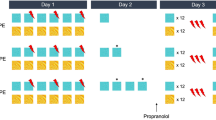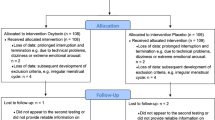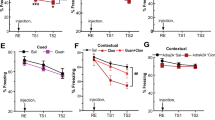Abstract
Exposure to traumatic events can lead to posttraumatic stress disorder (PTSD). Current PTSD treatments typically only produce partial improvement. Hence, there is a need for preclinical research to identify new candidate drugs and to develop novel therapeutic approaches. Animal studies have indicated that fear memories can be weakened by blocking restabilization after retrieval, a process known as reconsolidation. Furthermore, evidence suggests that there are important alterations of the noradrenergic system in PTSD, and hence it may be of interest to study drugs that target this pathway. Here, we investigated the efficacy of clonidine, an α2-adrenoreceptor agonist, to block reconsolidation in an animal model of persistent traumatic memories. Using an auditory fear conditioning paradigm in rats, we tested the efficacy of clonidine to weaken fear memory retention when administered systemically after retrieval. We evaluated dosage, number of treatments, and specificity in reconsolidation blockade. We found that postretrieval administration of clonidine disrupts fear-related memories in a dose-dependent manner and that two treatments are sufficient for maximal memory impairment. Furthermore, we determined that this effect is long lasting and specific to reconsolidation processes as shown by the selectivity to affect reactivated memories and the absence of spontaneous recovery and of postreactivation short-term memory impairment. Our results demonstrate the efficacy of systemic administration of clonidine following retrieval to persistently disrupt fear memory retention through reconsolidation blockade. This study provides important preclinical parameters for future therapeutic strategies involving clonidine to block reconsolidation as a novel treatment for PTSD symptoms.
Similar content being viewed by others
Log in or create a free account to read this content
Gain free access to this article, as well as selected content from this journal and more on nature.com
or
References
Ben Mamou C, Gamache K, Nader K (2006). NMDA receptors are critical for unleashing consolidated auditory fear memories. Nat Neurosci 9: 1237–1239.
Berger W, Mendlowicz MV, Marques-Portella C, Kinrys G, Fontenelle LF, Marmar CR et al (2009). Pharmacologic alternatives to antidepressants in posttraumatic stress disorder: a systematic review. Prog Neuropsychopharmacol Biol Psychiatry 33: 169–180.
Blanchard RJ, Blanchard DC (1969). Passive and active reactions to fear-eliciting stimuli. J Comp Physiol Psychol 68: 129–135.
Blundell J, Kouser M, Powell CM (2008). Systemic inhibition of mammalian target of rapamycin inhibits fear memory reconsolidation. Neurobiol Learn Mem 90: 28–35.
Boehnlein JK, Kinzie JD (2007). Pharmacologic reduction of CNS noradrenergic activity in PTSD: the case for clonidine and prazosin. J Psychiatr Pract 13: 72–78.
Brown 2nd DC, Co MS, Wolff RC, Atzori M (2012). alpha-Adrenergic receptors in auditory cue detection: alpha(2) receptor blockade suppresses false alarm responding in the rat. Neuropharmacology 62: 2178–2183.
Charney DS (2004). Psychobiological mechanisms of resilience and vulnerability: implications for successful adaptation to extreme stress. Am J Psychiatry 161: 195–216.
Conway EL, Jarrott B (1982). Tissue pharmacokinetics of clonidine in rats. J Pharmacokinet Biopharm 10: 187–200.
Davidson J, Rothbaum BO, Tucker P, Asnis G, Benattia I, Musgnung JJ (2006). Venlafaxine extended release in posttraumatic stress disorder: a sertraline- and placebo-controlled study. J Clin Psychopharmacol 26: 259–267.
Debiec J, Ledoux JE (2004). Disruption of reconsolidation but not consolidation of auditory fear conditioning by noradrenergic blockade in the amygdala. Neuroscience 129: 267–272.
Donnelly CL (2003). Pharmacologic treatment approaches for children and adolescents with posttraumatic stress disorder. Child Adolesc Psychiatr Clin N Am 12: 251–269.
Duvarci S, Nader K (2004). Characterization of fear memory reconsolidation. J Neurosci 24: 9269–9275.
Galeotti N, Bartolini A, Ghelardini C (2004). Alpha-2 agonist-induced memory impairment is mediated by the alpha-2A-adrenoceptor subtype. Behav Brain Res 153: 409–417.
Genkova-Papasova M, Lazarova-Bakurova M (1988). Influence of nootropic drugs on the memory-impairing effect of diethyldithiocarbamate and clonidine in “step down” passive avoidance in albino rats. Acta Physiol Pharmacol Bulg 14: 36–41.
Genkova-Papazova M, Petkova BP, Lazarova-Bakarova M, Boyanova E, Staneva-Stoytcheva D (1997). Effects of flunarizine and nitrendipine on electroconvulsive shock- and clonidine-induced amnesia. Pharmacol Biochem Behav 56: 583–587.
Gilsbach R, Hein L (2011). Are the pharmacology and physiology of alpha(2)-adrenoceptors determined by alpha(2)-heteroreceptors and autoreceptors, respectively? Br J Pharmacol 165: 90–102.
Hall JE, Uhrich TD, Ebert TJ (2001). Sedative, analgesic and cognitive effects of clonidine infusions in humans. Br J Anaesth 86: 5–11.
Harmon RJ, Riggs PD (1996). Clonidine for posttraumatic stress disorder in preschool children. J Am Acad Child Adolesc Psychiatry 35: 1247–1249.
Hawkins M, Monti JM (1979). Effects of pretreatment with 6-hydroxydopamine or noradrenergic receptor blockers on the clonidine-induced distruption of conditioned avoidance responding. Eur J Pharmacol 58: 53–58.
Homayoun H, Khavandgar S, Zarrindast MR (2003). Morphine state-dependent learning: interactions with alpha2-adrenoceptors and acute stress. Behav Pharmacol 14: 41–48.
Jakala P, Riekkinen M, Sirvio J, Koivisto E, Kejonen K, Vanhanen M et al (1999a). Guanfacine, but not clonidine, improves planning and working memory performance in humans. Neuropsychopharmacology 20: 460–470.
Jakala P, Riekkinen M, Sirvio J, Koivisto E, Riekkinen Jr P (1999b). Clonidine, but not guanfacine, impairs choice reaction time performance in young healthy volunteers. Neuropsychopharmacology 21: 495–502.
Jin XC, Lu YF, Yang XF, Ma L, Li BM (2007). Glucocorticoid receptors in the basolateral nucleus of amygdala are required for postreactivation reconsolidation of auditory fear memory. Eur J Neurosci 25: 3702–3712.
Jobim PF, Pedroso TR, Christoff RR, Werenicz A, Maurmann N, Reolon GK et al (2012). Inhibition of mTOR by rapamycin in the amygdala or hippocampus impairs formation and reconsolidation of inhibitory avoidance memory. Neurobiol Learn Mem 97: 105–112.
Kessler RC, Berglund P, Demler O, Jin R, Merikangas KR, Walters EE (2005). Lifetime prevalence and age-of-onset distributions of DSM-IV disorders in the National Comorbidity Survey Replication. Arch Gen Psychiatry 62: 593–602.
Kinzie JD, Leung P (1989). Clonidine in Cambodian patients with posttraumatic stress disorder. J Nerv Ment Dis 177: 546–550.
Kinzie JD, Sack RL, Riley CM (1994). The polysomnographic effects of clonidine on sleep disorders in posttraumatic stress disorder: a pilot study with Cambodian patients. J Nerv Ment Dis 182: 585–587.
Lakhlani PP, MacMillan LB, Guo TZ, McCool BA, Lovinger DM, Maze M et al (1997). Substitution of a mutant alpha2a-adrenergic receptor via “hit and run” gene targeting reveals the role of this subtype in sedative, analgesic, and anesthetic-sparing responses in vivo. Proc Natl Acad Sci USA 94: 9950–9955.
MacDonald E, Kobilka BK, Scheinin M (1997). Gene targeting--homing in on alpha 2-adrenoceptor-subtype function. Trends Pharmacol Sci 18: 211–219.
MacMillan LB, Hein L, Smith MS, Piascik MT, Limbird LE (1996). Central hypotensive effects of the alpha2a-adrenergic receptor subtype. Science 273: 801–803.
Nader K, Hardt O (2009). A single standard for memory: the case for reconsolidation. Nat Rev Neurosci 10: 224–234.
Nader K, Schafe GE, Le Doux JE (2000). Fear memories require protein synthesis in the amygdala for reconsolidation after retrieval. Nature 406: 722–726.
Onder E, Tural U, Aker T (2006). A comparative study of fluoxetine, moclobemide, and tianeptine in the treatment of posttraumatic stress disorder following an earthquake. Eur Psychiatry 21: 174–179.
Pitman RK, Milad MR, Igoe SA, Vangel MG, Orr SP, Tsareva A et al (2011). Systemic mifepristone blocks reconsolidation of cue-conditioned fear; propranolol prevents this effect. Behav Neurosci 125: 632–638.
Pitman RK, Orr SP, Shalev AY, Metzger LJ, Mellman TA (1999). Psychophysiological alterations in post-traumatic stress disorder. Semin Clin Neuropsychiatry 4: 234–241.
Porter DM, Bell CC (1999). The use of clonidine in post-traumatic stress disorder. J Natl Med Assoc 91: 475–477.
Przybyslawski J, Roullet P, Sara SJ (1999). Attenuation of emotional and nonemotional memories after their reactivation: role of beta adrenergic receptors. J Neurosci 19: 6623–6628.
Reagan-Shaw S, Nihal M, Ahmad N (2008). Dose translation from animal to human studies revisited. FASEB J 22: 659–661.
Riekkinen M, Laakso MP, Jakala P (1999). Clonidine impairs sustained attention and memory in Alzheimer's disease. Neuroscience 92: 975–982.
Siegmund A, Wotjak CT (2006). Toward an animal model of posttraumatic stress disorder. Ann NY Acad Sci 1071: 324–334.
Smith RJ, Aston-Jones G (2011). Alpha(2) Adrenergic and imidazoline receptor agonists prevent cue-induced cocaine seeking. Biol Psychiatry 70: 712–719.
Southwick SM, Bremner JD, Rasmusson A, Morgan 3rd CA, Arnsten A, Charney DS (1999). Role of norepinephrine in the pathophysiology and treatment of posttraumatic stress disorder. Biol Psychiatry 46: 1192–1204.
Southwick SM, Morgan 3rd CA, Bremner AD, Grillon CG, Krystal JH, Nagy LM et al (1997). Noradrenergic alterations in posttraumatic stress disorder. Ann NY Acad Sci 821: 125–141.
Steckler T, Risbrough V (2011). Pharmacological treatment of PTSD-established and new approaches. Neuropharmacology 62: 617–627.
Taubenfeld SM, Riceberg JS, New AS, Alberini CM (2009). Preclinical assessment for selectively disrupting a traumatic memory via postretrieval inhibition of glucocorticoid receptors. Biol Psychiatry 65: 249–257.
Viola J, Ditzler T, Batzer W, Harazin J, Adams D, Lettich L et al (1997). Pharmacological management of post-traumatic stress disorder: clinical summary of a five-year retrospective study, 1990–1995. Mil Med 162: 616–619.
Wilens TE (2006). Mechanism of action of agents used in attention-deficit/hyperactivity disorder. J Clin Psychiatry 67 (Suppl 8): 32–38.
Ziegenhorn AA, Roepke S, Schommer NC, Merkl A, Danker-Hopfe H, Perschel FH et al (2009). Clonidine improves hyperarousal in borderline personality disorder with or without comorbid posttraumatic stress disorder: a randomized, double-blind, placebo-controlled trial. J Clin Psychopharmacol 29: 170–173.
Acknowledgements
This work was supported by USARAA grant W81XWH-08-2-0126 (PT075809).
Author information
Authors and Affiliations
Corresponding author
Ethics declarations
Competing interests
The authors declare no conflict of interest.
Rights and permissions
About this article
Cite this article
Gamache, K., Pitman, R. & Nader, K. Preclinical Evaluation of Reconsolidation Blockade by Clonidine as a Potential Novel Treatment for Posttraumatic Stress Disorder. Neuropsychopharmacol 37, 2789–2796 (2012). https://doi.org/10.1038/npp.2012.145
Received:
Revised:
Accepted:
Published:
Issue date:
DOI: https://doi.org/10.1038/npp.2012.145
Keywords
This article is cited by
-
Activation of a novel α2AAR-spinophilin-cofilin axis determines the effect of α2 adrenergic drugs on fear memory reconsolidation
Molecular Psychiatry (2023)
-
Investigating the efficacy of the reminder-extinction procedure to disrupt contextual threat memories in humans using immersive Virtual Reality
Scientific Reports (2020)
-
Transcriptional Regulation Involved in Fear Memory Reconsolidation
Journal of Molecular Neuroscience (2018)
-
α2-adrenoceptor-mediated inhibition in the central amygdala blocks fear-conditioning
Scientific Reports (2017)
-
NOX2 Mediated-Parvalbumin Interneuron Loss Might Contribute to Anxiety-Like and Enhanced Fear Learning Behavior in a Rat Model of Post-Traumatic Stress Disorder
Molecular Neurobiology (2016)



